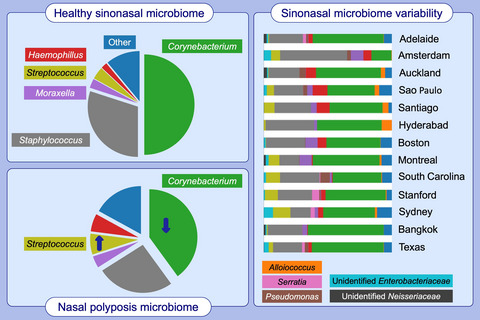Allergy:国际鼻窦微生物组学研究
发布日期:2020-10-23
原标题:国际鼻窦微生物组学研究:鼻腔细菌生态学的多中心、多民族特征

延伸阅读
JACI
DOI: 10.1111/all.14276
Abstract:
The sinonasal microbiome remains poorly defined, with our current knowledge based on a few cohort studies whose findings are inconsistent. Furthermore, the variability of the sinus microbiome across geographical divides remains unexplored. We characterize the sinonasal microbiome and its geographical variations in both health and disease using 16S rRNA gene sequencing of 410 individuals from across the world. Although the sinus microbial ecology is highly variable between individuals, we identify a core microbiome comprised of Corynebacterium, Staphylococcus, Streptococcus, Haemophilus and Moraxella species in both healthy and chronic rhinosinusitis (CRS) cohorts. Corynebacterium (mean relative abundance = 44.02%) and Staphylococcus (mean relative abundance = 27.34%) appear particularly dominant in the majority of patients sampled. Amongst patients suffering from CRS with nasal polyps, a statistically significant reduction in relative abundance of Corynebacterium (40.29% vs 50.43%; P = .02) was identified. Despite some measured differences in microbiome composition and diversity between some of the participating centres in our cohort, these differences would not alter the general pattern of core organisms described. Nevertheless, atypical or unusual organisms reported in short‐read amplicon sequencing studies and that are not part of the core microbiome should be interpreted with caution. The delineation of the sinonasal microbiome and standardized methodology described within our study will enable further characterization and translational application of the sinus microbiota.
First Author:
Sathish Paramasivan
Correspondence:
Alkis J. Psaltis, Department of Otolaryngology, Head and Neck Surgery, The Queen Elizabeth Hospital, 28 Woodville Road, Woodville South, SA 5011, Australia.
All Authors:
Sathish Paramasivan, Ahmed Bassiouni, Arron Shiffer, Matthew R. Dillon, Emily K. Cope, Clare Cooksley, Mahnaz Ramezanpour, Sophia Moraitis, Mohammad Javed Ali, Benjamin Bleier, Claudio Callejas, Marjolein E. Cornet, Richard G. Douglas, Daniel Dutra, Christos Georgalas, Richard J. Harvey, Peter H. Hwang, Amber U. Luong, Rodney J. Schlosser, Pongsakorn Tantilipikorn, Marc A. Tewfik, Sarah Vreugde, Peter-John Wormald, J. Gregory Caporaso, Alkis J. Psaltis
2020-09-03 Article
创建过敏性疾病的科研、科普知识交流平台,为过敏患者提供专业诊断、治疗、预防的共享平台。


——浙大迪迅 译
鼻窦微生物组的定义仍然不明确,我们目前的知识基于一些队列研究,但这些研究结果并不一致。此外,鼻窦微生物组跨地域差异的变异性仍待探索。我们利用16S rRNA基因测序对来自世界各地的410人进行了分析,确定了鼻窦微生物组及其在健康和疾病方面的地理变异。尽管个体之间的鼻窦微生物生态学差异很大,但我们确定了一个在健康和慢性鼻-鼻窦炎(CRS)人群中由棒状杆菌、葡萄球菌、链球菌、嗜血杆菌和莫拉氏菌组成的核心微生物组。棒状杆菌(平均相对丰度= 44.02%)和葡萄球菌(平均相对丰度= 27.34%)在大多数采样患者中表现出明显的优势。在患有鼻息肉的CRS患者中,发现棒状杆菌的相对丰度在统计学上有显着降低(40.29%比50.43%;P = .02)。尽管我们队列中某些参与中心之间的微生物组组成和多样性存在一定程度的测量差异,但这些差异不会改变所描述的核心生物体的总体模式。尽管如此,在短读扩增子测序研究中报告的非典型或异常生物,但不是核心微生物组的一部分,应谨慎解释。在我们的研究中描述的鼻窦微生物组的划定和标准化方法将使鼻窦微生物群的进一步表征和转化应用成为可能。
延伸阅读
JACI
[IF:6.771]
The international sinonasal microbiome study: A multicentre, multinational characterization of sinonasal bacterial ecologyDOI: 10.1111/all.14276
Abstract:
The sinonasal microbiome remains poorly defined, with our current knowledge based on a few cohort studies whose findings are inconsistent. Furthermore, the variability of the sinus microbiome across geographical divides remains unexplored. We characterize the sinonasal microbiome and its geographical variations in both health and disease using 16S rRNA gene sequencing of 410 individuals from across the world. Although the sinus microbial ecology is highly variable between individuals, we identify a core microbiome comprised of Corynebacterium, Staphylococcus, Streptococcus, Haemophilus and Moraxella species in both healthy and chronic rhinosinusitis (CRS) cohorts. Corynebacterium (mean relative abundance = 44.02%) and Staphylococcus (mean relative abundance = 27.34%) appear particularly dominant in the majority of patients sampled. Amongst patients suffering from CRS with nasal polyps, a statistically significant reduction in relative abundance of Corynebacterium (40.29% vs 50.43%; P = .02) was identified. Despite some measured differences in microbiome composition and diversity between some of the participating centres in our cohort, these differences would not alter the general pattern of core organisms described. Nevertheless, atypical or unusual organisms reported in short‐read amplicon sequencing studies and that are not part of the core microbiome should be interpreted with caution. The delineation of the sinonasal microbiome and standardized methodology described within our study will enable further characterization and translational application of the sinus microbiota.
First Author:
Sathish Paramasivan
Correspondence:
Alkis J. Psaltis, Department of Otolaryngology, Head and Neck Surgery, The Queen Elizabeth Hospital, 28 Woodville Road, Woodville South, SA 5011, Australia.
All Authors:
Sathish Paramasivan, Ahmed Bassiouni, Arron Shiffer, Matthew R. Dillon, Emily K. Cope, Clare Cooksley, Mahnaz Ramezanpour, Sophia Moraitis, Mohammad Javed Ali, Benjamin Bleier, Claudio Callejas, Marjolein E. Cornet, Richard G. Douglas, Daniel Dutra, Christos Georgalas, Richard J. Harvey, Peter H. Hwang, Amber U. Luong, Rodney J. Schlosser, Pongsakorn Tantilipikorn, Marc A. Tewfik, Sarah Vreugde, Peter-John Wormald, J. Gregory Caporaso, Alkis J. Psaltis
2020-09-03 Article
创建过敏性疾病的科研、科普知识交流平台,为过敏患者提供专业诊断、治疗、预防的共享平台。


 杭州浙大迪迅生物基因工程有限公司
杭州浙大迪迅生物基因工程有限公司

